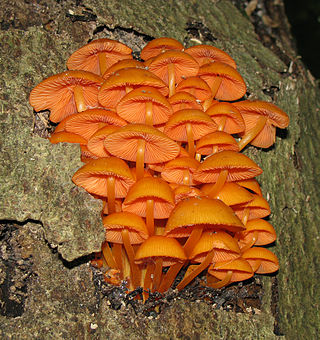
Mycena leaiana, commonly known as the orange mycena or Lea's mycena, is a species of saprobic fungi in the genus Mycena, family Mycenaceae. Characterized by their bright orange caps and stalks and reddish-orange gill edges, they usually grow in dense clusters on deciduous logs. The pigment responsible for the orange color in this species has antibiotic properties. A variety of the species, Mycena leaiana var. australis, can be found in Australia and New Zealand.

Mycena haematopus, commonly known as the bleeding fairy helmet, the burgundydrop bonnet, or the bleeding Mycena, is a species of fungus in the family Mycenaceae, of the order Agaricales. It is widespread and common in Europe and North America, and has also been collected in Japan and Venezuela. It is saprotrophic—meaning that it obtains nutrients by consuming decomposing organic matter—and the fruit bodies appear in small groups or clusters on the decaying logs, trunks, and stumps of deciduous trees, particularly beech. The fungus, first described scientifically in 1799, is classified in the section Lactipedes of the genus Mycena, along with other species that produce a milky or colored latex.
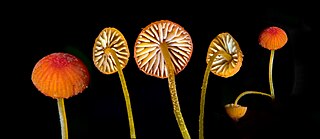
Mycena acicula, commonly known as the orange bonnet, or the coral spring Mycena, is a species of fungus in the family Mycenaceae. It is found in Asia, the Caribbean, North America and Europe. The fruit bodies, or mushrooms, of the fungus grow on dead twigs and other woody debris of forest floors, especially along streams and other wet places. They have small orange-red caps, up to 1 cm (0.4 in) in diameter, held by slender yellowish stems up to 6 cm (2.4 in) long. The gills are pale yellow with a whitish edge. Several other Mycena species look similar, but may be distinguished by differences in size and/or microscopic characteristics. M. acicula is considered inedible because of its small size.

Mycena adscendens, commonly known as the frosty bonnet, is a species of fungus in the family Mycenaceae. The fungus produces small white fruit bodies (mushrooms) with caps up to 7.5 mm (0.3 in) in diameter that appear to be dusted with sugar-like granules. Caps are supported by thin, hollow stems up to 20 mm (0.8 in) long, which are set on a disc-like base. Its distribution includes Europe, Turkey and the Pacific coast of the United States. The fruit bodies grow on fallen twigs and other woody debris on the forest floor, including fallen hazel nuts. The variety carpophila is known from Japan. There are several small white Mycena species that are similar in appearance to M. adscendens, some of which can be reliably distinguished only by examining microscopic characteristics.
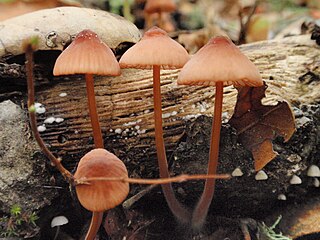
Mycena californiensis is a species of fungus in the family Mycenaceae. It is a common and abundant species in the coastal oak woodlands of California, where it grows saprobically, feeding on the fallen leaves and acorns of various oak species. First described in 1860 by Berkeley and Curtis, the species was collected four years earlier during an exploring and surveying expedition. It was subsequently considered a doubtful species by later Mycena researchers, until a 1999 publication validated the taxon. Mycena elegantula is considered a synonym.

Mycena aurantiomarginata, commonly known as the golden-edge bonnet, is a species of agaric fungus in the family Mycenaceae. First formally described in 1803, it was given its current name in 1872. Widely distributed, it is common in Europe and North America, and has also been collected in North Africa, Central America, and Japan. The fungus is saprobic, and produces fruit bodies (mushrooms) that grow on the floor of coniferous forests. The mushrooms have a bell-shaped to conical cap up to 2 cm in diameter, set atop a slender stipe up to 6 cm long with yellow to orange hairs at the base. The fungus is named after its characteristic bright orange gill edges. A microscopic characteristic is the club-shaped cystidia that are covered with numerous spiky projections, resembling a mace. The edibility of the mushroom has not been determined. M. aurantiomarginata can be distinguished from similar Mycena species by differences in size, color, and substrate. A 2010 publication reported the discovery and characterization of a novel pigment named mycenaaurin A, isolated from the mushroom. The pigment is responsible for its color, and it has antibiotic activity that may function to prevent certain bacteria from growing on the mushroom.

Mycena arcangeliana is a species of Mycenaceae fungus. It has been known by a number of scientific names, and its taxonomy is still somewhat disputed. It produces small mushrooms with caps varying in colour from whitish to a darker grey-brown, and stems of an olive-greyish that fade with age. The mushrooms can be mistaken for the similar Mycena flavescens. They have a mild taste, but a strong smell of iodoform; they are not edible. The species grows on dead wood in autumn months, and can be found throughout Europe.

Mycena minirubra is a species of fungus in the family Mycenaceae. Found only in New Zealand, the fungus produces tiny crimson fruit bodies with caps up to 1 mm (0.04 in) in diameter, atop that stems that arise from a basal disk of mycelium.
Mycena semivestipes is a species of agaric fungus in the family Mycenaceae. It is found in eastern North America.
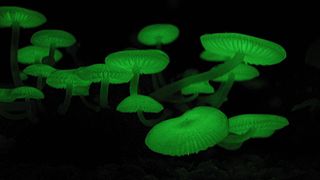
Mycena chlorophos is a species of agaric fungus in the family Mycenaceae. First described in 1860, the fungus is found in subtropical Asia, including India, Japan, Taiwan, Polynesia, Indonesia, and Sri Lanka, in Australia, and Brazil. Fruit bodies (mushrooms) have pale brownish-grey sticky caps up to 30 mm (1.2 in) in diameter atop stems 6–30 mm (0.2–1.2 in) long and up to a millimeter thick. The mushrooms are bioluminescent and emit a pale green light. Fruiting occurs in forests on fallen woody debris such as dead twigs, branches, and logs. The fungus can be made to grow and fruit in laboratory conditions, and the growth conditions affecting bioluminescence have been investigated.

Tricholoma fumosoluteum is a mushroom of the agaric genus Tricholoma. First described by Charles Horton Peck in 1875 as Agaricus fumosoluteus, it was transferred to the genus Tricholoma by Pier Andrea Saccardo in 1887.

Mycena purpureofusca, commonly known as the purple edge bonnet, is a species of agaric fungus in the family Mycenaceae. First described by Charles Horton Peck in 1885, the species is found in Europe and North America, where it grows on the decaying wood and debris of conifers, including cones. Fruit bodies have conical to bell-shaped purple caps up to 2.5 cm (1 in) set atop slender stipes up to 10 cm (4 in) long. The mushroom is named for the characteristic dark greyish-purple color of its gill edges. In the field, M. purpureofusca mushrooms can usually be distinguished from similar species by characteristics such as the dark purple gill edges, the deep purple cap center, and its cartilagineous consistency. The fungus contains a laccase enzyme that has been investigated scientifically for its potential to detoxify recalcitrant industrial dyes used in textile dyeing and printing processes.
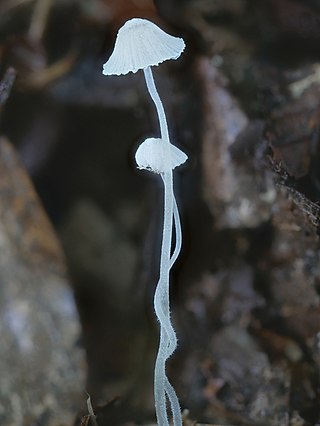
Mycena alphitophora is a species of agaric fungus in the family Mycenaceae. Its small, white, delicate fruit bodies are characterized by the powdery coatings on the surfaces of both the cap and stipe. The stipe base is not swollen or disk-like. The stipe surface is more hairy than Mycena adscendens.

Amanita ananiceps is a species of agaric fungus in the family Amanitaceae native to Australia.
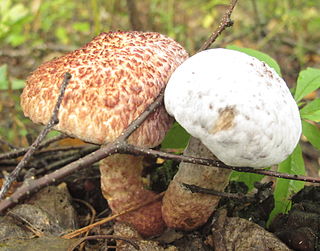
Hypomyces completus is a parasitic ascomycete in the order Hypocreales. The fungus grows on boletes, typically Suillus spraguei in North America, although the type collection was found on growing on Boletinus oxydabilis in Siberia. The color of its subiculum ranges from white initially to yellow-brown to greenish-brown to brown to black; the fruitbodies (perithecia) range from pale brown to dark brown to black. Spores measure 35–40 by 4–6 μm.

Geopyxis vulcanalis, commonly known as the vulcan pixie cup, is a species of cup fungus in the family Pyronemataceae. It was first described scientifically in 1878 by American mycologist Charles Horton Peck, from collections made in the Adirondack Mountains in Upstate New York. Pier Andrea Saccardo transferred it to the genus Geopyxis in 1889. Fruitbodies of G. vulcanalis are small and cup-like, with a light yellow hymenium. They become somewhat flattened in age. It grows on the ground in unburned conifer litter, often with mosses. Its spores are smooth and elliptical, measuring 14–21 by 8–11 µm.

Macrocybe crassa is a species of fungus that is native to Sri Lanka, India (Kerala), Thailand and Malaysia. The large pale cream to brownish mushrooms can weigh up to 1.25 kg and have 40 cm diameter caps. They are widely consumed and highly regarded.

Nigroporus vinosus is a species of poroid fungus in the family Steccherinaceae, and the type species of the genus Nigroporus. Its fruit bodies have brownish caps with tinges of purple or red. The cap underside has a pore surface the same colour as the cap, and minute pores. Nigroporus vinosus has a pantropical distribution. It has been recorded from Africa, North America, Central America, South America, Asia, and Oceania. It is a wood-decay fungus that causes a white rot.
Leucocoprinus holospilotus is a species of mushroom producing fungus in the family Agaricaceae.

















